Two of the pilgrims who travelled with us in the steps of St Paul, Canon Edmund and Rachel Plaxton have sent me their reflections on the pilgrimage.
We stayed overnight at The Premier Inn, Gatwick, conveniently sited opposite the travelator up to Departures….Astonishing numbers of people trundling cases to and fro so early, barely light….met up with McCabe rep easily, all arriving obediently before 4.40am ! Even so, we had travel a lot easier than St Paul !!
That evening, comfortably settled in The Galaxy Hotel, we strolled along the Aegean sea-front of Kavala, where St Paul first landed [Neapolis, then], now a pretty fishing harbour, busy with men repairing nets ready for the night’s fishing. Tiredness melted away, relaxed in arm-chairs beneath an umbrella, with choc ice, beer, crisps, nuts & cool water, all for four euro ! The Greek economy was in dire straits, but tourist areas still looked lovely. Greeks want to remain in Europe, feeling a proprietary right…after all Europe is named after their goddess, Europa !

Where Paul tied his boat, where we begin our pilgrimage
Next morning we were aboard the coach for Philippi, by 8.30am, rubber-necking the mosaic commemorating St Paul’s first-footing, then heading as Paul had done, for the river below Philippi, where Jews then met to worship, not having a Synagogue in the immense, prosperous, new town at that time. We held our Sunday Communion service there, beside the rushing water, in a simple little open air theatre, crossing the little bridges to the island-altar to receive bread & wine….hearing again how Paul baptised rich Lydia, seller of purple here, his first convert. French archaeologists have been excavating Philippi since 1914, uncovering the earliest 360BC settlement, around rich deposits of minerals, with timber & fertile land too. Later Philip of Macedonia gave his name to it, extending it magnificently, until 42BC, when victorious Octavian made Philippi a Roman Colony, expanding the city again to area administrative HQ….no wonder Paul chose to start his mission here !! And was pretty successful till he alienated the slave-girl’s owners by curing her of her embarrassing prophesying, so being flogged publically, thrown into prison, then rescued by an earthquake in the night…High drama ! The jailor with his entire household converted too. The city authorities begged Paul to leave, abjectly embarrassed at having flogged a Roman Citizen….
Monday morning had us coaching back to Thessalonica ….not much remaining of Paul’s time, but two fine basilicas, the White Tower and a high viewing point over the city. Paul had been chased out of Thessalonica, finding refuge in Berea, but had to escape again ahead of his enemies looking to silence him once for all. He sailed to Athens, while we toured south via the Meteora Monasteries and Delphi.
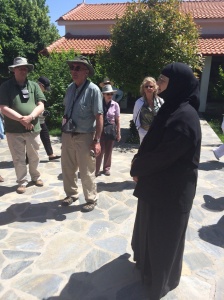
Sister Theoktisti greets us – Edmund is in the background
High-light for everyone was our visit to the modern, Orthodox nunnery of St John the Forerunner, high above Larissa, where nuns from all over the world joyfully devote their lives to God, farming ecologically, making everything they need, living simply and graciously welcoming visitors…and we had the place to our-selves… Their organic produce shop had us all buying gifts to take home….honey, olives, pasta, flower teas, remedies, icons, soaps, candles , all home-made….Their recommendation took us to a family restaurant down in the valley for the most delicious meal of the holiday, genuinely Greek. The Meteora landscape was astonishing, monasteries perched atop sheer rock pinnacles carved by the elements….once accessible only by basket on the end of a very long rope, dizzyingly high above the valley floor….ensuring safe retreat from the world. Two are open now to tourists, big-time, seething with coach-loads of sight-seers, come to view their mosaics and icons, and buy their very commercial gifts at inflated prices….interesting, but soulless, compared to the nuns’ above Larissa.
We found the family run Icon Factory really interesting. We saw beautiful work being painstakingly done…..They prefer to paint on recycled, aged wood, each one becoming a master-piece work of art ….Buyers were getting their chosen pieces signed by the head iconographer.
Having Dr Mark Vernon in our party was a bonus. He brought to life the Greek philosophy and culture of St Paul’s day, making our visit to Delphi revelatory. I had thought “ St Paul never went there, so why are we going, apart from satisfying curiosity while in the area?” Of course we had to go….no-one setting out on a project in its hey-day would have dreamed of NOT consulting the oracle ! [Who had spies finding out about the petitioners ’ requests ahead of consultation…only if the sacrificial goat shivered, when water was thrown at it, could the sacrifice go ahead…Goats HATE cold water, so easy to unobtrusively throw warm water, to buy time for divination!] It was up to petitioners to interpret cryptic oracles…as Socrates famously did, having heard from his friend’s consultation, “no -one is wiser”…asked politicians, poets, artisans…before realising “one thing I know for sure, I know nothing for sure”…he was cognisant of his ignorance….invaluable awareness !
Delphi is a honey-pot, but did not disappoint….seeing the ompholos stone, like a huge ostrich egg, grid-marked, was remarkable. In searing temperatures, and short of time, we did not quite get to the top of the site, but views were splendid…enough ruins to imagine the splendours of old, awe-inspiring still. No wonder Greek culture pervaded the Mediterranean world, so that Cynic ideas seem to have filtered into Jesus’ sayings, certainly into Paul’s teaching. The Cynics were bare-foot philosophers, taking no thought for the morrow, what to wear, or eat, where to sleep, or wash…hence their derisory name, Greek for “dog”….They had a respect for all life, knowing each part of the body, however lowly, is necessary to the whole. [very Pauline !]
Athens we’d seen before, but not the wonderful museums, so a fine browsing, and The Acropolis rises above the city, magnificently as ever. Resentment about the Elgin Marbles still being in The British Museum, runs high…even though they WERE paid for by Lord Elgin, and have been saved ravages of time and earthquakes suffered by the rest of the site …. We visited early, before the sun’s heat became intense, and ahead of the hordes… This time pausing in shade for one of our daily worships, at the Areopagus, site of Paul’s sermon, making him very close.

A last view of Corinth – the Temple of Apollo
The Corinth canal had not been built in Paul’s day. However it was worth portering cargoes across the narrow neck of land, saving the long haul round the Peloponnese. Corinth had grown rich on the trade dues, so a large city for Paul’s evangelism, where he stayed, earned his keep tent-making and established a lively church. Priscilla & Aquila were principal converts here. We stopped off at The Elysian Fields, in Eleusis, superbly off the tourist track…I’d always wondered where they were. Mark Vernon told the story of Persephone’s abduction by Pluto to the Underworld, and her mother’s tireless search till she found her, gaining her daughter’s return each year for summer…even the cave Pluto in his fiery chariot was said to have burst out from, is there…. All made the Greek Gods less alien for me….Their intrigues, jealousies, selfish affairs, violent anger, and self- indulgences had had me amazed that they could have been worshiped….but I learned that there was an observant, behaviour-logic to their junketing affairs and the naming of their off-spring…It is good there was an altar to The Unknown God in Athens for St Paul to build his teaching on and that many recognised Christ as a result.
Lunch our last day was at a restaurant at the Eastern mouth of the Corinth Canal. We watched, cameras at the ready, for the road barriers either side to come down and for the road-bridge to lower to the sea bottom, so several yachts and a big ship could come through dramatically. All the diners crowded to view and wave….Satisfactory, seeing the canal in use!

‘O happy band of pilgrims….’
We had come to the end of our pilgrimage, so ably led by The Dean, Andrew Nunn…Friendships from Santiago de Compostela two years ago, renewed; inspiring worship times, much learned, and a fuller understanding gained of St Paul, his times, his tough journeys, his brave witness, his great achievements.






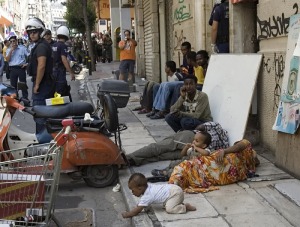



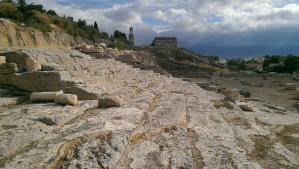

















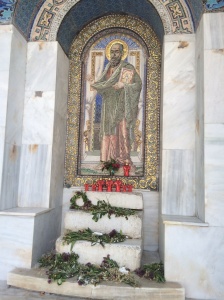



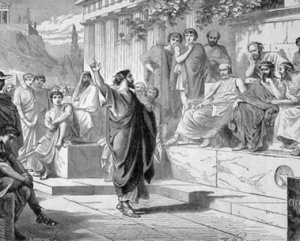




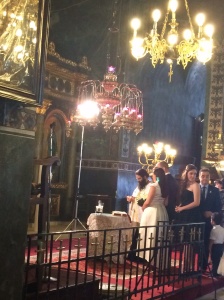





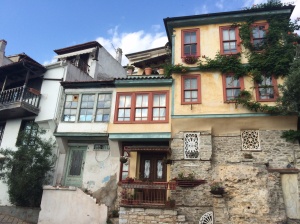
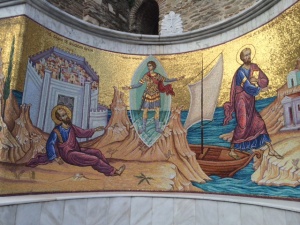


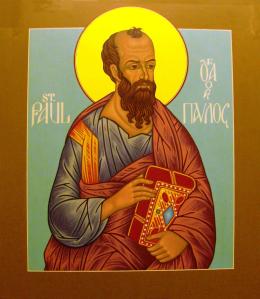

You must be logged in to post a comment.